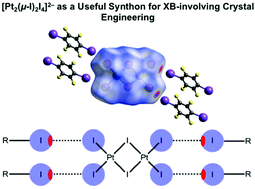当前位置:
X-MOL 学术
›
Dalton Trans.
›
论文详情
Our official English website, www.x-mol.net, welcomes your feedback! (Note: you will need to create a separate account there.)
Hexaiododiplatinate(ii) as a useful supramolecular synthon for halogen bond involving crystal engineering.
Dalton Transactions ( IF 4 ) Pub Date : 2020-01-02 , DOI: 10.1039/c9dt04221k Anastasiya A Eliseeva 1 , Daniil M Ivanov , Alexander S Novikov , Anton V Rozhkov , Ilya V Kornyakov , Alexey Yu Dubovtsev , Vadim Yu Kukushkin
Dalton Transactions ( IF 4 ) Pub Date : 2020-01-02 , DOI: 10.1039/c9dt04221k Anastasiya A Eliseeva 1 , Daniil M Ivanov , Alexander S Novikov , Anton V Rozhkov , Ilya V Kornyakov , Alexey Yu Dubovtsev , Vadim Yu Kukushkin
Affiliation

|
Hexaiododiplatinates(ii) bearing ammonium and phosphonium cations, [R4N]2[Pt2(μ-I)2I4] {R = Et (1) and n-Bu (2)} and [R3PR1]2[Pt2(μ-I)2I4] {R = n-Bu and R1 = n-Bu (3); R = Ph and R1 = Ph (4); R = Ph and R1 = CH2Ph (5)}, were synthesized and characterized by high resolution ESI-MS, 1H, 13C{1H}, 31P{1H}, and 195Pt NMR spectroscopy, Fourier transform infrared and Raman spectroscopy, X-ray diffraction (XRD), X-ray powder diffraction, and also electrostatic surface potential calculations. Complexes 1-3 were cocrystallized with halogen bond (XB) donors based on organic iodides featuring electron withdrawing groups {REWGIs: 1,3,5-triiodotrifluorobenzene (1,3,5-FIB), iodopentafluorobenzene (IPFB), 1,4-diiodotetrafluorobenzene (1,4-FIB), and tetraiodoethylene (C2I4)} to give crystalline adducts 1·2(1,3,5-FIB), 1·2IPFB, 2·2(1,4-FIB), and 3·C2I4. Inspection of the XRD data of the obtained adducts revealed the presence, in all four structures, of intermolecular REWGII-Pt XBs between the iodine centers of REWGIs and the terminal iodide ligands of [Pt2(μ-I)2I4]2- anions, where the latter act as rectangular XB-accepting synthons forming XBs with two, three, and even four Pt-Iterminal ligands. The results of Hirshfeld molecular surface analysis and density functional theory (DFT) calculations (the M06/DZP-DKH level of theory) followed by topological analysis of the electron density distribution within the framework of Bader's approach (QTAIM) confirmed the existence of the detected XBs, and their estimated energies vary from 2.2 to 4.7 kcal mol-1.
中文翻译:

六碘二铂酸盐(ii)作为涉及晶体工程的卤素键的有用的超分子合成子。
带有铵和phospho阳离子,[R4N] 2 [Pt2(μ-I)2I4] {R = Et(1)和n-Bu(2)}和[R3PR1] 2 [Pt2(μ-I)的六碘二铂酸盐(ii) [2I4] {R = n-Bu,R1 = n-Bu(3);R = Ph和R1 = Ph(4); R = Ph和R1 = CH2Ph(5)},是通过高分辨率ESI-MS,1H,13C {1H},31P {1H}和195Pt NMR光谱,傅里叶变换红外和拉曼光谱,X射线合成并表征的衍射(XRD),X射线粉末衍射以及静电表面电势计算。配合物1-3与卤素键(XB)供体基于具有吸电子基团的有机碘化物共结晶(REWGIs:1,3,5-三碘三氟苯(1,3,5-FIB),碘五氟苯(IPFB),1,4-二碘四氟苯(1,4-FIB)和四碘乙烯(C2I4)},得到结晶加合物1·2(1,3,5-FIB),1·2IPFB,2·2(1,4-FIB)和3· C2I4。检查获得的加合物的XRD数据后发现,在所有四个结构中,REWGI的碘中心与[Pt2(μ-I)2I4] 2-阴离子的末端碘配体之间都存在分子间REWGII-Pt XB。后者充当矩形XB接受合成子,形成具有两个,三个甚至四个Pt-I末端配体的XB。Hirshfeld分子表面分析和密度泛函理论(DFT)计算(M06 / DZP-DKH水平理论)的结果,然后在Bader方法(QTAIM)框架内对电子密度分布进行拓扑分析,证实了存在检测到的XB及其估计的能量在2.2至4.7 kcal mol-1之间变化。REWGI的碘中心与[Pt2(μ-I)2I4] 2-阴离子的末端碘配体之间的分子间REWGII-Pt XB的分布,其中后者充当矩形XB接受的合成子,形成具有两个,三个,甚至偶数个XB的XB。四个Pt-I末端配体。Hirshfeld分子表面分析和密度泛函理论(DFT)计算(M06 / DZP-DKH水平理论)的结果,然后在Bader方法(QTAIM)框架内对电子密度分布进行拓扑分析,证实了存在检测到的XB及其估计的能量在2.2至4.7 kcal mol-1之间变化。REWGI的碘中心与[Pt2(μ-I)2I4] 2-阴离子的末端碘配体之间的分子间REWGII-Pt XB的分布,其中后者充当矩形XB接受的合成子,形成具有两个,三个,甚至偶数个XB的XB。四个Pt-I末端配体。Hirshfeld分子表面分析和密度泛函理论(DFT)计算(M06 / DZP-DKH水平理论)的结果,然后在Bader方法(QTAIM)框架内对电子密度分布进行拓扑分析,证实了存在检测到的XB及其估计的能量在2.2至4.7 kcal mol-1之间变化。
更新日期:2020-01-08
中文翻译:

六碘二铂酸盐(ii)作为涉及晶体工程的卤素键的有用的超分子合成子。
带有铵和phospho阳离子,[R4N] 2 [Pt2(μ-I)2I4] {R = Et(1)和n-Bu(2)}和[R3PR1] 2 [Pt2(μ-I)的六碘二铂酸盐(ii) [2I4] {R = n-Bu,R1 = n-Bu(3);R = Ph和R1 = Ph(4); R = Ph和R1 = CH2Ph(5)},是通过高分辨率ESI-MS,1H,13C {1H},31P {1H}和195Pt NMR光谱,傅里叶变换红外和拉曼光谱,X射线合成并表征的衍射(XRD),X射线粉末衍射以及静电表面电势计算。配合物1-3与卤素键(XB)供体基于具有吸电子基团的有机碘化物共结晶(REWGIs:1,3,5-三碘三氟苯(1,3,5-FIB),碘五氟苯(IPFB),1,4-二碘四氟苯(1,4-FIB)和四碘乙烯(C2I4)},得到结晶加合物1·2(1,3,5-FIB),1·2IPFB,2·2(1,4-FIB)和3· C2I4。检查获得的加合物的XRD数据后发现,在所有四个结构中,REWGI的碘中心与[Pt2(μ-I)2I4] 2-阴离子的末端碘配体之间都存在分子间REWGII-Pt XB。后者充当矩形XB接受合成子,形成具有两个,三个甚至四个Pt-I末端配体的XB。Hirshfeld分子表面分析和密度泛函理论(DFT)计算(M06 / DZP-DKH水平理论)的结果,然后在Bader方法(QTAIM)框架内对电子密度分布进行拓扑分析,证实了存在检测到的XB及其估计的能量在2.2至4.7 kcal mol-1之间变化。REWGI的碘中心与[Pt2(μ-I)2I4] 2-阴离子的末端碘配体之间的分子间REWGII-Pt XB的分布,其中后者充当矩形XB接受的合成子,形成具有两个,三个,甚至偶数个XB的XB。四个Pt-I末端配体。Hirshfeld分子表面分析和密度泛函理论(DFT)计算(M06 / DZP-DKH水平理论)的结果,然后在Bader方法(QTAIM)框架内对电子密度分布进行拓扑分析,证实了存在检测到的XB及其估计的能量在2.2至4.7 kcal mol-1之间变化。REWGI的碘中心与[Pt2(μ-I)2I4] 2-阴离子的末端碘配体之间的分子间REWGII-Pt XB的分布,其中后者充当矩形XB接受的合成子,形成具有两个,三个,甚至偶数个XB的XB。四个Pt-I末端配体。Hirshfeld分子表面分析和密度泛函理论(DFT)计算(M06 / DZP-DKH水平理论)的结果,然后在Bader方法(QTAIM)框架内对电子密度分布进行拓扑分析,证实了存在检测到的XB及其估计的能量在2.2至4.7 kcal mol-1之间变化。


























 京公网安备 11010802027423号
京公网安备 11010802027423号